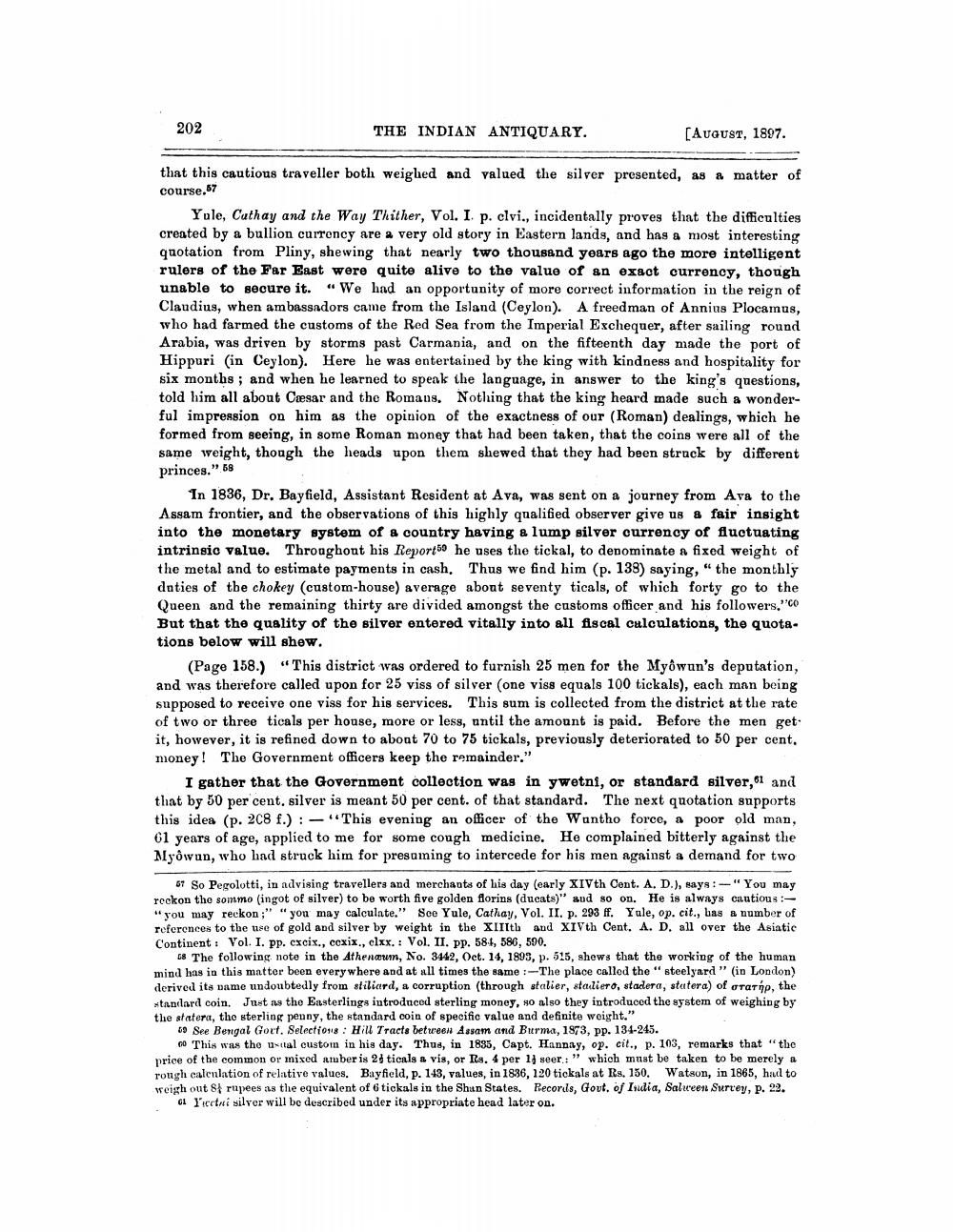________________
202
THE INDIAN ANTIQUARY.
that this cautious traveller both weighed and valued the silver presented, as a matter of course.57
[AUGUST, 1897.
Yule, Cathay and the Way Thither, Vol. I. p. clvi., incidentally proves that the difficulties created by a bullion currency are a very old story in Eastern lands, and has a most interesting quotation from Pliny, shewing that nearly two thousand years ago the more intelligent rulers of the Far East were quite alive to the value of an exact currency, though unable to secure it. "We had an opportunity of more correct information in the reign of Claudius, when ambassadors came from the Island (Ceylon). A freedman of Annius Plocamus, who had farmed the customs of the Red Sea from the Imperial Exchequer, after sailing round Arabia, was driven by storms past Carmania, and on the fifteenth day made the port of Hippuri (in Ceylon). Here he was entertained by the king with kindness and hospitality for six months; and when he learned to speak the language, in answer to the king's questions, told him all about Cæsar and the Romans. Nothing that the king heard made such a wonderful impression on him as the opinion of the exactness of our (Roman) dealings, which he formed from seeing, in some Roman money that had been taken, that the coins were all of the same weight, though the heads upon them shewed that they had been struck by different princes." 58
In 1836, Dr. Bayfield, Assistant Resident at Ava, was sent on a journey from Ava to the Assam frontier, and the observations of this highly qualified observer give us a fair insight into the monetary system of a country having a lump silver currency of fluctuating intrinsic value. Throughout his Report59 he uses the tickal, to denominate a fixed weight of the metal and to estimate payments in cash. Thus we find him (p. 138) saying, "the monthly duties of the chokey (custom-house) average about seventy ticals, of which forty go to the Queen and the remaining thirty are divided amongst the customs officer and his followers,"co But that the quality of the silver entered vitally into all fiscal calculations, the quotations below will shew.
(Page 158.) "This district was ordered to furnish 25 men for the Myôwun's deputation, and was therefore called upon for 25 viss of silver (one viss equals 100 tickals), each man being supposed to receive one viss for his services. This sum is collected from the district at the rate of two or three ticals per house, more or less, until the amount is paid. Before the men get it, however, it is refined down to about 70 to 75 tickals, previously deteriorated to 50 per cent. money! The Government officers keep the remainder."
I gather that the Government collection was in ywetni, or standard silver," and that by 50 per cent, silver is meant 50 per cent. of that standard. The next quotation supports this idea (p. 208 f.): "This evening an officer of the Wantho force, a poor old man, 61 years of age, applied to me for some cough medicine. He complained bitterly against the Myowun, who had struck him for presuming to intercede for his men against a demand for two
57 So Pegolotti, in advising travellers and merchants of his day (early XIVth Cent. A. D.), says: "You may reckon the sommo (ingot of silver) to be worth five golden florins (ducats)" and so on. He is always cautious:"you may reckon;" "you may calculate." See Yule, Cathay, Vol. II. p. 293 ff. Yule, op. cit., has a number of references to the use of gold and silver by weight in the XIIIth and XIVth Cent. A. D. all over the Asiatic Continent: Vol. I. pp. cxcix., cexix., clxx.: Vol. II. pp. 584, 586, 590.
18 The following note in the Athenæum, No. 3442, Oct. 14, 1893, p. 515, shews that the working of the human mind has in this matter been everywhere and at all times the same :-The place called the "steelyard" (in London) derived its name undoubtedly from stiliard, a corruption (through stalier, stadiero, stadera, statera) of orarip, the standard coin. Just as the Easterlings introduced sterling money, so also they introduced the system of weighing by the statera, the sterling penny, the standard coin of specific value and definite weight."
59 See Bengal Gort. Selections: Hill Tracts between Assam and Burma, 1873, pp. 134-245.
co This was the usual custom in his day. Thus, in 1835, Capt. Hannay, op. cit., p. 103, remarks that "the price of the common or mixed amber is 23 ticals a vis, or Rs. 4 per 14 seer.:" which must be taken to be merely a rough calculation of relative values. Bayfield, p. 143, values, in 1836, 120 tickals at Rs. 150. Watson, in 1865, had to weigh out 84 rupees as the equivalent of 6 tickals in the Shan States. Records, Govt. of India, Salween Survey, p. 22. cctai silver will be described under its appropriate head later on.
61




